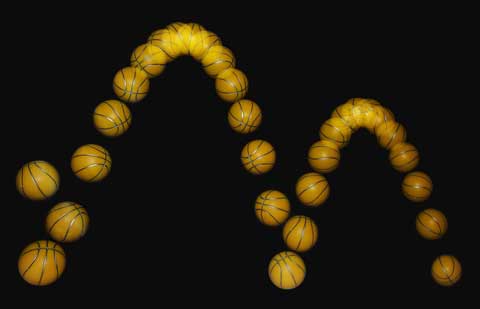Bouncing Ball

A bouncing ball captured with a stroboscopic flash at 25 images per second.
Image by Michael Maggs and Edit by Richard Bartz
The simple act of bouncing a ball may not conjure up feelings of physics, but there is more physics going on than meets the eye. In this image, 25 pictures were taken each second. When superimposed, a beautiful image of a bouncing ball, looking like a graph emerges, making the physics come forward.
If a ball were to bounce in a vacuum, devoid of all air resistance, it would make a parabola, or an upside down u-shaped curve. The curve in the image is not a perfect parabola. Air resistance as well as spin can alter the motion of the bouncing ball, preventing the bounce from taking the shape of a perfect parabola.
The ball moves in two planes: vertical (up and down) and horizontal (moving forward). In the vertical plane when the ball is in motion – falling or bouncing– it has kinetic energy and for a split second at the top of its path it stops moving up and hasn’t yet started falling down again; here is where it exhibits potential energy or stored energy.
As the ball falls it accelerates – speeds up – due to the force of gravity. In the picture the space between the images of the ball are further apart nearer the ground, where acceleration would be the greatest. As kinetic energy decreases and is converted into potential energy near the peak of the ball’s path, the ball decelerates, slowing down. Because the ball has slowed its upward movement the images of the ball get closer together. As the potential energy is converted back into kinetic energy and the ball begins to fall again. The ball continues to accelerate until it hits the ground, losing some energy in impact which, along with air resistance, makes each successive bounce lower.











